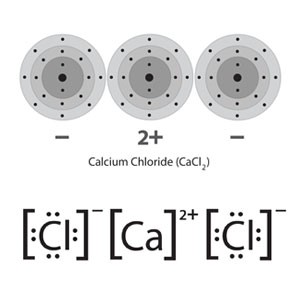Suppose 26 g of calcium chloride CaCl2 (110.98 g / mol) are dissolved in water to make 200 mL of solution. How many times greater is the molarity of chloride ions (Cl − ) than the molarity of calcium ions (Ca2+ ) in the solution?
1 Answer
Here's what I got.
Explanation:
The key here is to realize that a solution of calcium chloride,
You know that every formula unit of calcium chloride contains
This means that one mole of calcium chloride, which contains one mole of formula units of calcium chloride, will have
- one mole of calcium cations,
#1 xx "Ca"^(2+)# - two moles of chloride anions,
#2 xx "Cl"^(-)#
Therefore, you can say that the concentration of chloride anions in any solution of calcium chloride will be twice as high as that of the calcium cations.
You don't have to calculate the actual concentrations of the two ions, all you have to say is that
#["Cl"^(-)] = 2 xx ["Ca"^(2+)]#
Now, calcium chloride dissociates to produce
#"CaCl"_ (2(aq)) -> "Ca"_ ((aq))^(2+) + 2"Cl"_ ((aq))^(-)#
The sample given to you contains
#26 color(red)(cancel(color(black)("g"))) * "1 mole CaCl"_2/(110.98color(red)(cancel(color(black)("g")))) = "0.2343 moles CaCl"_2#
The solution will thus contain
#{("0.2343 moles Ca"^(2+)), (2 xx "0.02343 moles Cl"^(-)):}#
The concentrations of the two ions will be -- keep in mind that you must use liters of solution !
#["Ca"^(2+)] = "0.02343 moles Ca"^(2+)/(200 * 10^(-3)"L") = color(darkgreen)(ul(color(black)("0.12 M")))#
#["Cl"^(-)] = (2 xx "0.2343 moles Cl"^(-))/(200 * 10^(-3)"L") = 2 xx "0.12 M" = color(darkgreen)(ul(color(black)("0.24 M")))#


